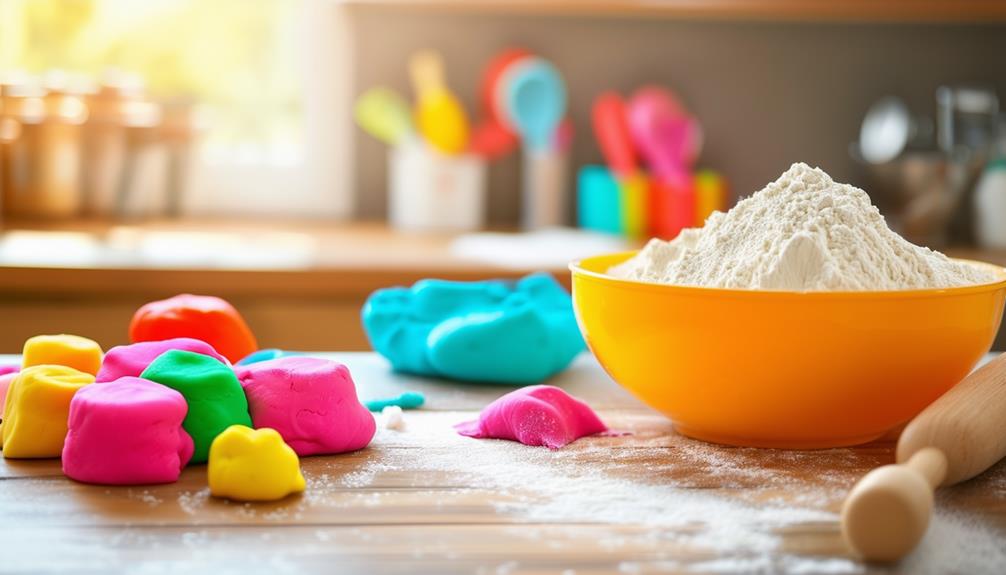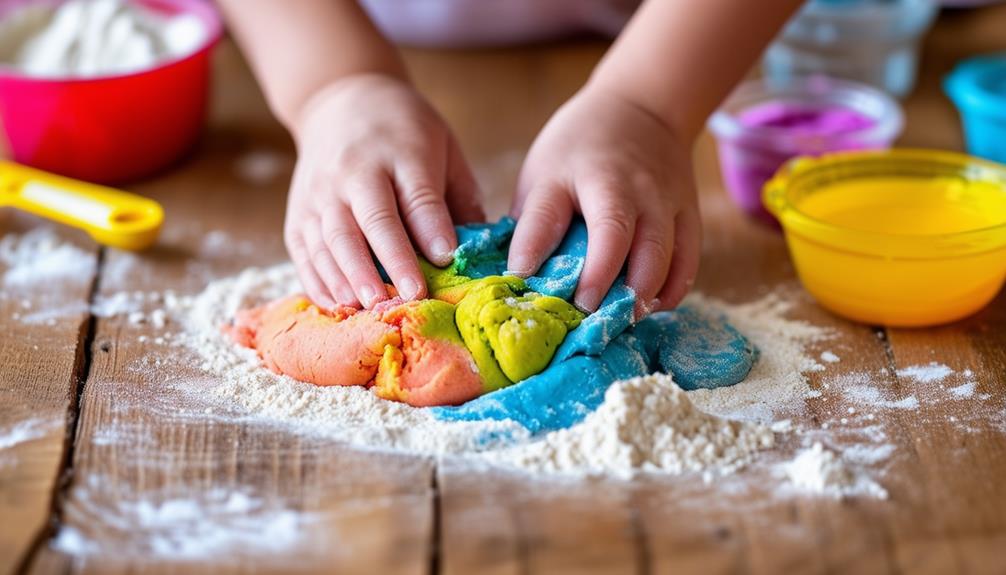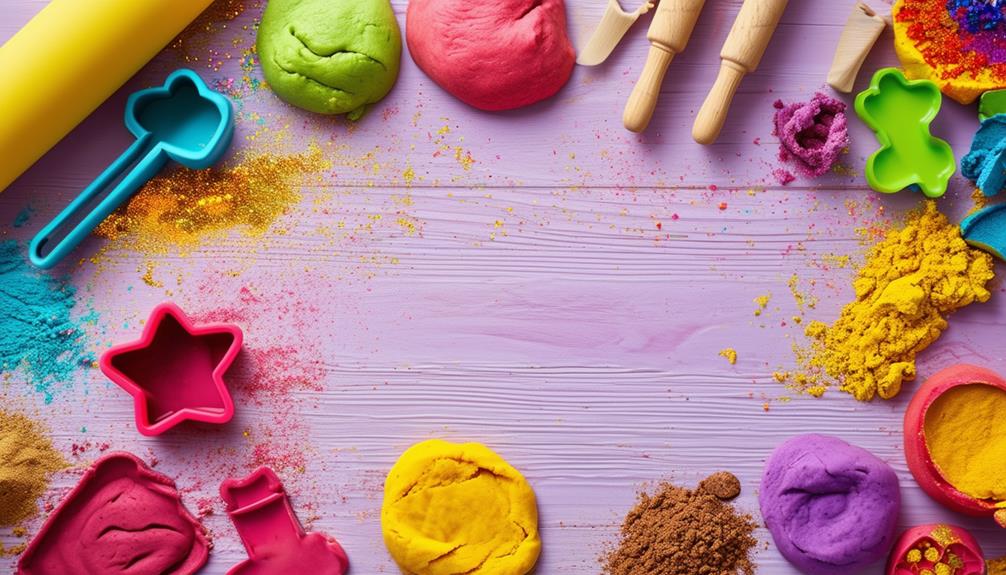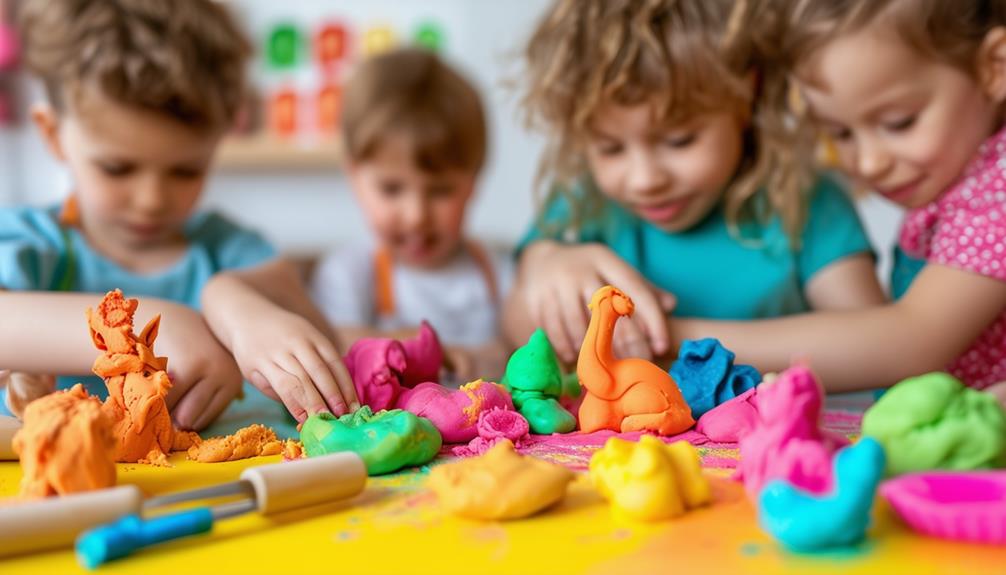How to Make Homemade Playdough: A Step-by-Step Guide

Creating homemade playdough is a cost-effective and enjoyable activity that can enhance your child's fine motor skills and spark their creativity. To get started, gather basic ingredients such as flour, salt, and cream of tartar. Follow a few straightforward steps to mix these ingredients and form the dough. The real fun begins when you add colors and textures, transforming the dough into a vibrant, sensory-rich experience. Want to know how to achieve the perfect texture and bright colors? Follow this detailed guide to ensure your homemade playdough exceeds expectations.
Benefits of Homemade Playdough
Homemade playdough offers numerous benefits, making it an excellent sensory activity for children. By creating playdough at home, you provide more than just a fun pastime; you offer a rich sensory experience that stimulates multiple senses. The soft, squishy texture is ideal for little hands to explore, aiding in the development of fine motor skills. As children knead, roll, and shape the dough, they strengthen hand muscles and enhance dexterity.
One of the greatest advantages is that homemade playdough fosters creativity. Children can mold it into anything their imagination envisions, from animals to abstract forms. This type of open-ended play is beneficial for cognitive development and problem-solving skills. Additionally, making playdough at home is cost-effective. With common household ingredients, you can create playdough at a fraction of the cost of store-bought versions.
Another benefit is the ability to customize it. You can add various colors and scents to make the sensory experience more engaging. When properly stored, homemade playdough can last for months, offering long-lasting entertainment and value. So, go ahead and make a batch for endless fun and developmental benefits!
Ingredients and Equipment
To make homemade playdough, you'll need the following ingredients: flour, salt, cream of tartar, lukewarm water, and vegetable oil. For equipment, gather a large mixing bowl, a spoon for stirring, and a pot for cooking. Optionally, you can include food coloring for variety and storage containers to keep the playdough fresh.
Essential Playdough Ingredients
Creating the perfect homemade playdough involves just a few key ingredients and basic kitchen tools. You'll need all-purpose flour as the base, salt to improve texture, and cream of tartar to add flexibility and elasticity. Warm water helps achieve the right consistency, while vegetable oil prevents sticking and enhances pliability.
Gathering these ingredients—flour, salt, cream of tartar, water, and vegetable oil—is your first step toward making playdough that rivals any store-bought version. These components are likely already in your pantry, making this project both convenient and economical. Each ingredient serves a specific purpose: flour provides structure, salt enhances texture, cream of tartar adds elasticity, water ensures the correct consistency, and vegetable oil ensures smoothness and prevents sticking.
Necessary Cooking Tools
Now that you have your ingredients ready, let's gather the necessary cooking tools to bring your homemade playdough to life. First, grab a large mixing bowl to combine your dry ingredients like flour, salt, and cream of tartar. This ensures everything blends evenly before adding any liquids.
Next, locate a large pot for mixing and heating the ingredients together. Ensure it's big enough to hold the entire batch of playdough without overflowing. Additionally, you'll need a sturdy spoon, preferably wooden or silicone, to handle the thick dough without breaking.
Prepare lukewarm water for blending the dry ingredients smoothly during heating. Also, keep vegetable oil nearby to add a smooth texture and prevent the playdough from drying out quickly.
Optional Add-ons
Enhance your homemade playdough with a variety of optional add-ons to enrich the sensory experience. These elements can make playdough more engaging and beneficial for sensory play. Here are a few ideas to get you started:
- Scented Oils: Add a few drops of essential oils like lavender or peppermint to your playdough mix. This not only makes the playdough smell delightful but also provides a calming effect, making playtime a relaxing experience.
- Glitter and Natural Colors: For visual appeal, mix in some glitter for a sparkly effect. For vibrant colors, use natural dyes such as beet juice or turmeric powder. These non-toxic options can create a stunning array of hues.
- Textures: Elevate the tactile experience by incorporating textured materials like oatmeal, cornmeal, or coffee grounds. These additions make the playdough feel more interesting, adding a new dimension to sensory play.
Remember to use essential tools like measuring cups, mixing bowls, stirring spoons, and airtight containers for storage. These extras not only enhance the sensory experience but also make the playdough more fun and engaging for children.
Step-by-Step Instructions

To make homemade playdough, begin by combining the following ingredients in a mixing bowl:
| Ingredient | Quantity |
|---|---|
| Salt | 1 cup |
| Flour | 2 cups |
| Oil | 2 tablespoons |
| Cream of Tartar | 2 tablespoons |
This recipe ensures you get a smooth and pliable dough. Next, add 1 cup of cooled water to the mixture and stir until it forms a dough. If the dough is too sticky, incorporate a bit more flour. Once the ingredients are well-combined, knead the dough on a flat surface for about five minutes until it becomes smooth and pliable.
To create multiple colors, divide the dough into portions. Use gel food coloring to achieve vibrant hues, kneading each portion until the color is evenly distributed. You can also mix primary colors to create secondary ones for added fun. This straightforward guide guarantees perfect playdough for little hands.
Tips for Coloring and Storing
To achieve vibrant colors in your homemade playdough, use food coloring sparingly and knead thoroughly. Start with a few drops and gradually add more if needed. Excessive food coloring can make the dough sticky and difficult to work with. For even coloring, knead the dough until the color is uniformly distributed.
To maintain the quality of your playdough, follow these tips:
- Store Separately: Place different colored dough in separate airtight containers to prevent colors from mixing.
- Cool, Dry Place: Keep your playdough away from direct sunlight and store it in a cool, dry location to prevent mold growth and color fading.
- Essential Oils: Adding a few drops of essential oils can make your playdough smell delightful. Popular choices include lavender, peppermint, and citrus.
Airtight containers are essential for storing your playdough. They prevent the dough from drying out and help maintain its consistency. If you notice any signs of mold growth, it's time to make a fresh batch. By following these simple steps, your homemade playdough will stay soft, colorful, and ready for playtime whenever you need it.
Creative Variations

Enhance your homemade playdough experience by incorporating creative variations that engage the senses and ensure safety for young children. Scented playdough can be made by adding essential oils such as lavender or peppermint, which not only provide delightful aromas but also promote relaxation and focus.
For a safe and edible option, you can create playdough using ingredients like peanut butter, powdered sugar, and milk. This kitchen-friendly dough is perfect for younger children who may be inclined to taste their creations.
To achieve vibrant, chemical-free colors, consider making natural dye playdough. Ingredients like beet juice, spinach, or turmeric can be used to produce visually appealing hues while adding a natural touch.
For unique tactile experiences, try texture playdough. Incorporate materials like rice, sand, or seeds to create diverse textures that stimulate fine motor skills. Glitter playdough is another exciting option; simply mix in some glitter to add a bit of sparkle and make playtime even more fun.
These creative variations transform regular playdough into a multi-sensory adventure, enriching the play experience for children.
Hands-On Learning Benefits
Making playdough at home isn't just enjoyable; it's an excellent way to enhance your child's sensory skills and creativity. When they knead, shape, and mold the dough, their senses are stimulated, and their imagination is sparked. These hands-on activities foster creative play and contribute to their overall development.
Enhances Sensory Skills
Engaging in playdough activities enhances your child's sensory skills and fine motor development. Manipulating playdough offers sensory exploration through tactile stimulation, allowing your child to experience various textures and temperatures. This hands-on activity is excellent for developing fine motor skills as it requires pinching, rolling, and shaping the dough, which strengthens hand muscles and improves dexterity.
Playdough also enhances hand-eye coordination. As your child molds and shapes the dough, they learn to sync their hand movements with their visual input, a crucial skill for tasks like writing and drawing. Here are some examples of what your child might experience:
- Squishing the soft, pliable dough between their fingers: Improves tactile sensitivity and hand strength.
- Rolling the dough into different shapes and sizes: Enhances fine motor skills and hand-eye coordination.
- Pressing objects into the dough to create imprints: Adds a sensory dimension to play, stimulating the sense of touch.
These activities collectively contribute to better sensory processing and motor skills, laying a strong foundation for future learning and development.
Encourages Creative Play
Homemade playdough sparks creativity by providing children with a hands-on medium to explore their imagination and artistic talents. Engaging with playdough is more than just fun; it's a form of creative play essential for their development. Molding and shaping the dough enable children to express emotions and ideas tangibly, fostering a deeper connection with their thoughts and feelings.
Playdough activities also offer a valuable sensory learning experience. The tactile actions of squishing, rolling, and cutting the dough enrich cognitive development and enhance problem-solving skills. Children will enjoy the texture of homemade playdough, and this sensory interaction can improve their focus and learning abilities.
Additionally, manipulating playdough strengthens fine motor skills. Actions like rolling small balls or pressing shapes develop the muscles in their fingers and hands, crucial for tasks such as writing and buttoning clothes. The sense of accomplishment from creating with their own hands builds pride and boosts confidence. So, get some homemade playdough and watch your children's creativity and skills flourish!




